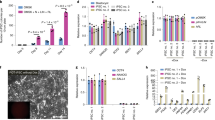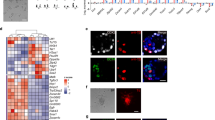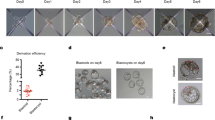Abstract
Molecular and embryology studies have demonstrated that mouse pre-implantation embryo development is a process of progressive cell fate determination. At the time of implantation, three cell lineages are present in the developing blastocyst: the trophectoderm (TE), the epiblast (Epi) and the primitive endoderm (PrE). From these early embryo cells, trophoblast stem (TS) cells, embryonic stem (ES) cells and extra-embryonic endoderm stem (XEN) cells can be derived. Recently, we derived stem cells with blastomere-like features from mouse cleavage-stage embryos, which we named expanded-potential stem cells (EPSCs). Here, we provide detailed protocols that describe how to establish EPSCs from single eight-cell-stage blastomeres or whole eight-cell pre-implantation mouse embryos, or by conversion of mouse ES cells or induced pluripotent stem (iPS) cells reprogrammed from fibroblasts. It takes 2–3 weeks to derive EPSCs from each cell source. The EPSCs derived from these protocols can differentiate into all embryonic and extra-embryonic lineages when implanted into chimeras. Furthermore, bona fide TS and XEN cell lines can be derived from EPSCs in vitro.
This is a preview of subscription content, access via your institution
Access options
Access Nature and 54 other Nature Portfolio journals
Get Nature+, our best-value online-access subscription
$29.99 / 30 days
cancel any time
Subscribe to this journal
Receive 12 print issues and online access
$259.00 per year
only $21.58 per issue
Buy this article
- Purchase on Springer Link
- Instant access to full article PDF
Prices may be subject to local taxes which are calculated during checkout











Similar content being viewed by others
Data availability
The data that support the findings of this study are available from the corresponding author upon request. Source data for Fig. 10 are available online.
References
Hamatani, T., Carter, M. G., Sharov, A. A. & Ko, M. S. Dynamics of global gene expression changes during mouse preimplantation development. Dev. Cell 6, 117–131 (2004).
Lyon, M. F. Gene action in the X-chromosome of the mouse (Mus musculus L.). Nature 190, 372–373 (1961).
Gu, T. P. et al. The role of Tet3 DNA dioxygenase in epigenetic reprogramming by oocytes. Nature 477, 606–610 (2011).
Guo, F. et al. Active and passive demethylation of male and female pronuclear DNA in the mammalian zygote. Cell Stem Cell 15, 447–459 (2014).
Rougier, N. et al. Chromosome methylation patterns during mammalian preimplantation development. Genes Dev. 12, 2108–2113 (1998).
Bedzhov, I., Graham, S. J., Leung, C. Y. & Zernicka-Goetz, M. Developmental plasticity, cell fate specification and morphogenesis in the early mouse embryo. Philos. Trans. R. Soc. Lond. B Biol. Sci. 369, 20130538 (2014).
Saiz, N. & Plusa, B. Early cell fate decisions in the mouse embryo. Reproduction 145, R65–R80 (2013).
Evans, M. J. & Kaufman, M. H. Establishment in culture of pluripotential cells from mouse embryos. Nature 292, 154–156 (1981).
Kunath, T. et al. Imprinted X-inactivation in extra-embryonic endoderm cell lines from mouse blastocysts. Development 132, 1649–1661 (2005).
Martin, G. R. Isolation of a pluripotent cell line from early mouse embryos cultured in medium conditioned by teratocarcinoma stem cells. Proc. Natl. Acad. Sci. USA 78, 7634–7638 (1981).
Tanaka, S., Kunath, T., Hadjantonakis, A. K., Nagy, A. & Rossant, J. Promotion of trophoblast stem cell proliferation by FGF4. Science 282, 2072–2075 (1998).
Macfarlan, T. S. et al. Embryonic stem cell potency fluctuates with endogenous retrovirus activity. Nature 487, 57–63 (2012).
Choi, Y. J. et al. Deficiency of microRNA miR-34a expands cell fate potential in pluripotent stem cells. Science 355, eaag1927 (2017).
Morgani, S. M. et al. Totipotent embryonic stem cells arise in ground-state culture conditions. Cell Rep. 3, 1945–1957 (2013).
Yang, J. et al. Establishment of mouse expanded potential stem cells. Nature 550, 393–397 (2017).
Tarkowski, A. K. & Wroblewska, J. Development of blastomeres of mouse eggs isolated at the 4- and 8-cell stage. J. Embryol. Exp. Morphol. 18, 155–180 (1967).
Yamanaka, Y., Ralston, A., Stephenson, R. O. & Rossant, J. Cell and molecular regulation of the mouse blastocyst. Dev. Dyn. 235, 2301–2314 (2006).
Johnson, M. H. & Ziomek, C. A. The foundation of two distinct cell lineages within the mouse morula. Cell 24, 71–80 (1981).
Yagi, R. et al. Transcription factor TEAD4 specifies the trophectoderm lineage at the beginning of mammalian development. Development 134, 3827–3836 (2007).
Nishioka, N. et al. The Hippo signaling pathway components Lats and Yap pattern Tead4 activity to distinguish mouse trophectoderm from inner cell mass. Dev. Cell 16, 398–410 (2009).
Piccolo, S., Dupont, S. & Cordenonsi, M. The biology of YAP/TAZ: hippo signaling and beyond. Physiol. Rev. 94, 1287–1312 (2014).
Azzolin, L. et al. YAP/TAZ incorporation in the beta-catenin destruction complex orchestrates the Wnt response. Cell 158, 157–170 (2014).
Sonderegger, S., Pollheimer, J. & Knofler, M. Wnt signalling in implantation, decidualisation and placental differentiation--review. Placenta 31, 839–847 (2010).
Chan, S. W. et al. Hippo pathway-independent restriction of TAZ and YAP by angiomotin. J. Biol. Chem. 286, 7018–7026 (2011).
Wang, W., Huang, J. & Chen, J. Angiomotin-like proteins associate with and negatively regulate YAP1. J. Biol. Chem. 286, 4364–4370 (2011).
Zhao, B. et al. Angiomotin is a novel Hippo pathway component that inhibits YAP oncoprotein. Genes Dev. 25, 51–63 (2011).
Wang, W. et al. Tankyrase inhibitors target YAP by stabilizing angiomotin family proteins. Cell Rep. 13, 524–532 (2015).
Lu, C. W. et al. Ras-MAPK signaling promotes trophectoderm formation from embryonic stem cells and mouse embryos. Nat. Genet. 40, 921–926 (2008).
Maekawa, M. et al. Requirement of the MAP kinase signaling pathways for mouse preimplantation development. Development 132, 1773–1783 (2005).
Li, X. et al. Calcineurin-NFAT signaling critically regulates early lineage specification in mouse embryonic stem cells and embryos. Cell Stem Cell 8, 46–58 (2011).
Kapoor, A. et al. Yap1 activation enables bypass of oncogenic Kras addiction in pancreatic cancer. Cell 158, 185–197 (2014).
Shao, D. D. et al. KRAS and YAP1 converge to regulate EMT and tumor survival. Cell 158, 171–184 (2014).
Wilson, M. B., Schreiner, S. J., Choi, H. J., Kamens, J. & Smithgall, T. E. Selective pyrrolo-pyrimidine inhibitors reveal a necessary role for Src family kinases in Bcr-Abl signal transduction and oncogenesis. Oncogene 21, 8075–8088 (2002).
Martello, G. et al. Esrrb is a pivotal target of the Gsk3/Tcf3 axis regulating embryonic stem cell self-renewal. Cell Stem Cell 11, 491–504 (2012).
Ying, Q. L. et al. The ground state of embryonic stem cell self-renewal. Nature 453, 519–523 (2008).
Zimmerlin, L. et al. Tankyrase inhibition promotes a stable human naive pluripotent state with improved functionality. Development 143, 4368–4380 (2016).
Kim, H. et al. Modulation of beta-catenin function maintains mouse epiblast stem cell and human embryonic stem cell self-renewal. Nat. Commun. 4, 2403 (2013).
Ryan, D. J., Yang, J., Lan, G. & Liu, P. Derivation and maintenance of mouse expanded potential stem cells. Protoc. Exch. https://doi.org/10.1038/protex.2017.102 (2017).
Baker, C. L. & Pera, M. F. Capturing totipotent stem cells. Cell Stem Cell 22, 25–34 (2018).
Niakan, K. K., Schrode, N., Cho, L. T. & Hadjantonakis, A. K. Derivation of extraembryonic endoderm stem (XEN) cells from mouse embryos and embryonic stem cells. Nat. Protoc. 8, 1028–1041 (2013).
Matsunari, H. et al. Blastocyst complementation generates exogenic pancreas in vivo in apancreatic cloned pigs. Proc. Natl. Acad. Sci. USA 110, 4557–4562 (2013).
Yang, Y. et al. Derivation of pluripotent stem cells with in vivo embryonic and extraembryonic potency. Cell 169, 243–257.e25 (2017).
Hemberger, M. et al. Parp1-deficiency induces differentiation of ES cells into trophoblast derivatives. Dev. Biol. 257, 371–381 (2003).
Yang, J. et al. Signalling through retinoic acid receptors is required for reprogramming of both mouse embryonic fibroblast cells and epiblast stem cells to induced pluripotent stem cells. Stem Cells 33, 1390–1404 (2015).
Hung, S. S. et al. Repression of global protein synthesis by Eif1a-like genes that are expressed specifically in the two-cell embryos and the transient Zscan4-positive state of embryonic stem cells. DNA Res. 20, 391–402 (2013).
Sasaki, H., Ferguson-Smith, A. C., Shum, A. S., Barton, S. C. & Surani, M. A. Temporal and spatial regulation of H19 imprinting in normal and uniparental mouse embryos. Development 121, 4195–4202 (1995).
Thomas, K. R. & Capecchi, M. R. Site-directed mutagenesis by gene targeting in mouse embryo-derived stem cells. Cell 51, 503–512 (1987).
McMahon, A. P. & Bradley, A. The Wnt-1 (int-1) proto-oncogene is required for development of a large region of the mouse brain. Cell 62, 1073–1085 (1990).
Acknowledgements
We thank our colleagues from the research support facility (M. Woods, C. Sinclair, E. Brown, B. Doe, S. Newman, E. Grau and others) at the Sanger Institute and the animal facility at CRUK-CI. The P.L. lab was supported by the Wellcome Trust (grant numbers: 098051 and 206194) and internal funding from the University of Hong Kong.
Author information
Authors and Affiliations
Contributions
J.Y. and D.J.R. drafted the protocol. J.Y., D.J.R. and P.L. wrote the protocol with inputs from G.L. and X.Z. The initial observations of pre-implantation embryos in EPSCM were made by D.J.R. Most experiments presented in this protocol were performed by J.Y. All chimeric blastocysts were generated by G.L. and X.Z.
Corresponding authors
Ethics declarations
Competing interests
Genome Research Limited has filed a provisional patent application that covers the derivation and maintenance of EPSCs (WO2016079146). P.L., D.J.R. and J.Y. are listed as inventors. The other authors declare no competing interests.
Additional information
Publisher’s note: Springer Nature remains neutral with regard to jurisdictional claims in published maps and institutional affiliations.
Related link
Key reference using this protocol
Yang, J. et al. Nature 550, 393–397 (2017) https://doi.org/10.1038/nature24052
Integrated supplementary information
Supplementary Figure 1 Diagrams of constructs.
These constructs include episomal vectors used in MEF reprogramming experiment and PB vectors used in EPSCs transfection. CAG: CMV early enhancer/chick β-actin; SV40/pA: SV40 polyA; Orip: origin of plasmid replication; EBNA-1: EBV nuclear antigen 1; T2A, E2A: 2A peptides; bpA: bovine growth hormone polyA.
Supplementary Figure 2 Gating strategy.
Non-transfected EPSCs (DR25) were used as negative control. In all sorting experiments, cell population was initially identified on a FSC/SSC plot, using a polygon gate to separate distinct cell population from debris and feeder (over 85%). The boundary between positive and negative was determined by negative control. And negative population in control was over 99.5%. Using these gates, the sample, DR25-EPSCs transfected with an mCherry fluorescence reporter construct was sorted (76.5% mCherry positive) and plated. a. Negative control, untransfected DR25-EPSCs. b. Sample, DR25-EPSCs transfected with PBCAGmCherry.
Supplementary information
Supplementary Text and Figures
Supplementary Figures 1 and 2, and Supplementary Table 1
Source data
Rights and permissions
About this article
Cite this article
Yang, J., Ryan, D.J., Lan, G. et al. In vitro establishment of expanded-potential stem cells from mouse pre-implantation embryos or embryonic stem cells. Nat Protoc 14, 350–378 (2019). https://doi.org/10.1038/s41596-018-0096-4
Published:
Issue Date:
DOI: https://doi.org/10.1038/s41596-018-0096-4
This article is cited by
-
An optimized culture system for efficient derivation of porcine expanded potential stem cells from preimplantation embryos and by reprogramming somatic cells
Nature Protocols (2024)
-
Methanol fixed feeder layers altered the pluripotency and metabolism of bovine pluripotent stem cells
Scientific Reports (2022)
-
Etv5 safeguards trophoblast stem cells differentiation from mouse EPSCs by regulating fibroblast growth factor receptor 2
Molecular Biology Reports (2020)
-
Establishment of porcine and human expanded potential stem cells
Nature Cell Biology (2019)
Comments
By submitting a comment you agree to abide by our Terms and Community Guidelines. If you find something abusive or that does not comply with our terms or guidelines please flag it as inappropriate.



